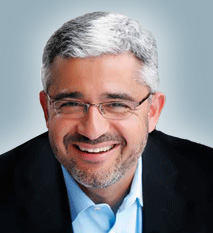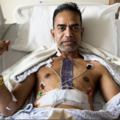Surgeon Interview: Dr. Husam Balkhy Extends Robotic Surgery To Aortic Valve Replacement
By Adam Pick on July 7, 2010
This is an exciting time for the medical treatment of diseased heart valves. As demonstrated in prior blogs, unique technologies are rapidly evolving to correct heart valve disorders including stenotic aortic valves and regurgitant mitral valves. That said, conversations specific to minimally invasive heart valve procedures often stimulate exciting clinical and patient possibilities.

Dr. Husam Balkhy
On this note, I recently had the opportunity to interview Dr. Husam Balkhy at the University of Chicago. As you may remember, Dr. Balkhy has been intimately involved in the adaptive use of the Da Vinci surgical robot for aortic valve replacement surgery.
If you are interested in learning more about the current and future use of robotics for aortic valve replacement, please read the interview notes provided below:
Adam: Thanks so much for taking time to speak with me today. I’d like to ask you a couple questions about robotic AVR.
Dr. Husam Balkhy: No trouble Adam. Thanks for the opportunity. I think you ‘re doing great work in helping patients learn about these issues by the way.
Adam: To start, I’m curious to know about you and your practice. How long have you been at The University of Chicago?
Dr. Husam Balkhy: Adam I’ve practiced in Southeastern Wisconsin starting in 1997. I was at The Wisconsin Heart Hospital since 2004 – when it first opened. Now, I’m at the University of Chicago.
Adam: Is heart valve surgery a core part of your practice? Can you estimate the percentage of procedures you perform that involve valve repair or valve replacement?
Dr. Husam Balkhy: Yes, I do a significant number of valve procedures in my practice and this has been increasing over the last several years. I would say that just over 50-60% of my practice is valve and arrhythmia surgery. The other part of my practice focuses mainly on coronary artery disease and I have a very large experience with totally endoscopic coronary bypass using the da Vinci robot.
Adam: So, a good portion of your practice includes mitral valve repair using the Da Vinci robot?
Dr. Husam Balkhy: Yes that is correct. About 50% of my isolated valve cases are robotic mitral valve repairs (using the da Vinci robot), and 50% are minimally invasive aortic valve replacements.
Adam: When did your interest in aortic valve replacement using the robot begin?
Dr. Husam Balkhy: I began doing minimally invasive aortic valve surgery using port access techniques regularly in 2006. In my practice, this is done through a small opening between the ribs to the right of the upper part of the breastbone. Since I began using the robot for mitral valve and coronary surgery in 2007, I’ve always felt that we should be able to improve upon aortic valve procedures with the superior visualization and access using robotics.
Adam: How did you transform your “interest” into actual clinical success? What was involved? How long did it take?
Dr. Husam Balkhy: After I gained a significant amount of experience using the da Vinci robot in well-established procedures, it was only a matter of time until I began thinking about the logistics of using the robot to aid in my minimally invasive aortic valve operations. I collaborated with colleagues from around the country to figure out how to position the robotic arms, scope, etc. This required several sessions using cadaver and animal models over many months until we were ready to do a clinical case. This is the way most new procedures are developed.
Adam: Interesting… How many robotic AVR procedures have your performed on human patients?
Dr. Husam Balkhy: This approach is still in its infancy but has great promise. Less than a handful of these procedures have been performed in the United States. Thus far, I have performed only one robotic AVR in a patient with a severely leaky valve and normal aortic root. This is not a common combination in aortic valve disease, so until the development of newer instrumentation we’re still looking for the right patients for this approach.
Adam: Do you foresee robotic aortic valve replacements increasing? If so, why?
Dr. Husam Balkhy: Yes, I think that number will increase significantly once the instruments for removing all the calcium from a diseased valve become more available. As you know, the most common indication for replacing an aortic valve is aortic stenosis, which results from deposition of calcified plaque onto the native valve. The other important development will be that of sutureless and stentless prosthetic aortic valves that can be implanted easily through very small openings. The robotic assisted approach will figure prominently in these cases.
Adam: What is the interest level in robotic AVR from your peers? Do you see this procedure becoming as prevalent as robotic mitral valve repair?
Dr. Husam Balkhy: We had a robotic AVR group meeting at our recent national society (AATS) in Toronto last month. The enthusiasm was indeed high in that most of the robotic surgeons that were experienced in minimally invasive aortic valve procedures wanted to incorporate the robot in their aortic surgeries. It will take some time before this becomes as prevalent as mitral valve surgery done with the robot, given the vast experience gained in multiple centers with these techniques for the mitral valve over the last 10 years.
Adam: Has there been much resistance to this approach to aortic valve replacement?
Dr. Husam Balkhy: I think most surgeons doing minimally invasive heart surgery agree that isolated aortic valve replacement should be done through small incisions without opening the chest. Currently, this is done without the assistance of robotics and is fairly widely accepted and performed by many cardiac surgeons around the world. Adding robotic assistance to make it even less invasive is a new concept but belongs to the same mindset. Those of us working on it are validating the procedure carefully in a stepwise fashion to get to a truly endoscopic approach.

ATS 3f Bioprosthesis
Adam: I noticed that the ATS 3f Bioprosthesis Aortic Valve has been used in the most publicized robotic AVRs by you and Dr. Raczkowski. What is unique about that device relative to this cardiac procedure?
Dr. Husam Balkhy: The ATS 3f Biprosthesis Aortic Valve is one of those stenteless valves I mentioned earlier that allows it to be delivered into the chest through a small port, and for it to be implanted using a different suturing technique that lends itself well to the robotic assisted approach. The newer generations of this valve (which is now only approved in Europe) will allow implantation without sutures even. I think that is exciting news for our patients once we get FDA approval in the United States.
Adam: Thanks so much Dr. Balkhy for chatting with me today. I really appreciate it!
Dr. Husam Balkhy: Thanks Adam. And, keep up the good work with your book and website!














